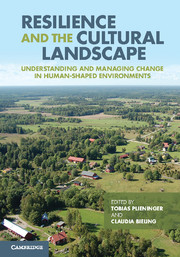 Resilience and the Cultural Landscape
Resilience and the Cultural Landscape Book contents
- Frontmatter
- Contents
- List of contributors
- Preface
- Part I Conceptualising landscapes as social–ecological systems
- 1 Connecting cultural landscapes to resilience
- 2 Landscapes as integrating frameworks for human, environmental and policy processes
- 3 From cultural landscapes to resilient social–ecological systems: transformation of a classical paradigm or a novel approach?
- 4 Conceptualising the human in cultural landscapes and resilience thinking
- 5 System or arena? Conceptual concerns around the analysis of landscape dynamics
- 6 Resilience thinking versus political ecology: understanding the dynamics of small-scale, labour-intensive farming landscapes
- Part II Analysing landscape resilience
- Part III Managing landscapes for resilience
- Part IV Perspectives for resilient landscapes
- Index
- References
1 - Connecting cultural landscapes to resilience
Published online by Cambridge University Press: 05 November 2012
- Frontmatter
- Contents
- List of contributors
- Preface
- Part I Conceptualising landscapes as social–ecological systems
- 1 Connecting cultural landscapes to resilience
- 2 Landscapes as integrating frameworks for human, environmental and policy processes
- 3 From cultural landscapes to resilient social–ecological systems: transformation of a classical paradigm or a novel approach?
- 4 Conceptualising the human in cultural landscapes and resilience thinking
- 5 System or arena? Conceptual concerns around the analysis of landscape dynamics
- 6 Resilience thinking versus political ecology: understanding the dynamics of small-scale, labour-intensive farming landscapes
- Part II Analysing landscape resilience
- Part III Managing landscapes for resilience
- Part IV Perspectives for resilient landscapes
- Index
- References
Summary
Two views on values and changes of cultural landscapes
First-time visitors are fascinated by the traditional dehesa landscapes of Extremadura, the remote southwestern part of Spain (Figure 1.1). Gently rolling hills provide spectacular views of seemingly endless and undisturbed landscapes and wildlife. Globally threatened bird and mammal species such as the Spanish imperial eagle or the Iberian lynx strive over and through this landscape. Shepherds guide their flocks from winter to summer pastures, following historic routes of transhumance often over hundreds of kilometres. Local landraces of sheep, cattle and pigs; scenic stone walls; historic farm estates; ancient oak trees and other traditional landscape elements remind Northern Europeans and Americans of the losses in values that their native landscapes have suffered. All this is not a natural landscape feature, but the result of a ‘10 000 years love story’ between man and nature, as Blondel (2006) notes. The dehesa, which combines livestock husbandry, crop cultivation and management of Holm oaks and Cork oaks in an agroforestry system, is perfectly adapted to the local resource constraints imposed by the rough environmental conditions of a dry Mediterranean climate and shallow, acidic and nutrient-poor soils. Dehesas are described as the material expression of people having shaped their local landscapes in a sustainable way. It is hardly surprising that the dehesa landscape has become the embodiment of a traditional cultural landscape of high nature value in conservation policy and practice, but also in the general public.
- Type
- Chapter
- Information
- Resilience and the Cultural LandscapeUnderstanding and Managing Change in Human-Shaped Environments, pp. 3 - 26Publisher: Cambridge University PressPrint publication year: 2012
References
- 24
- Cited by


